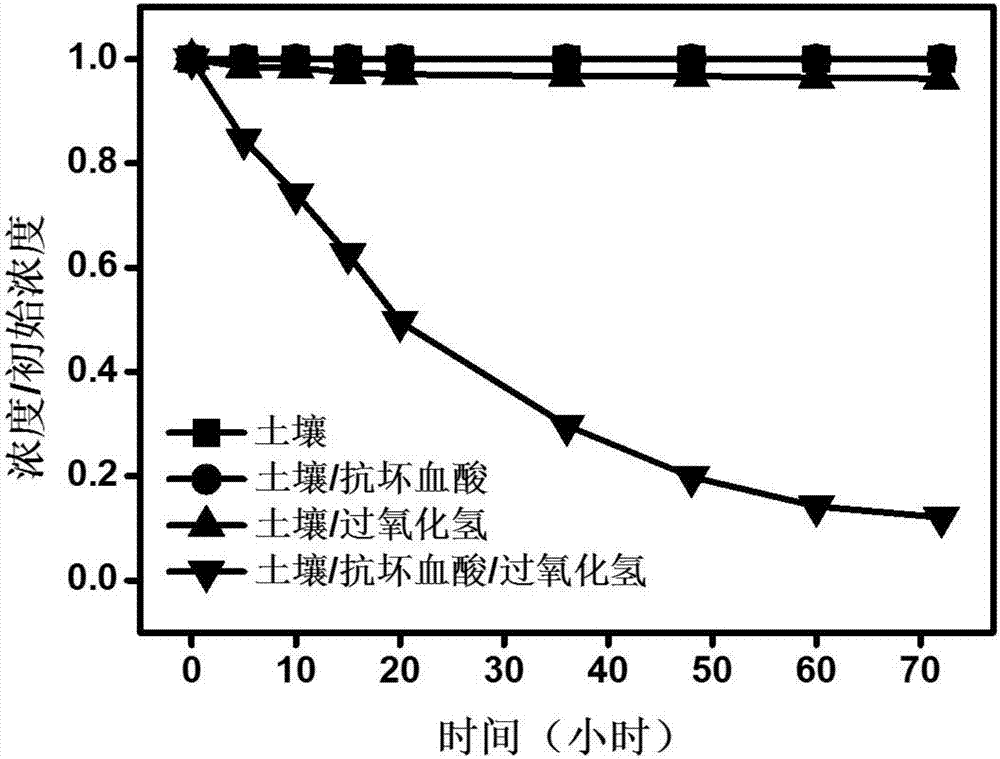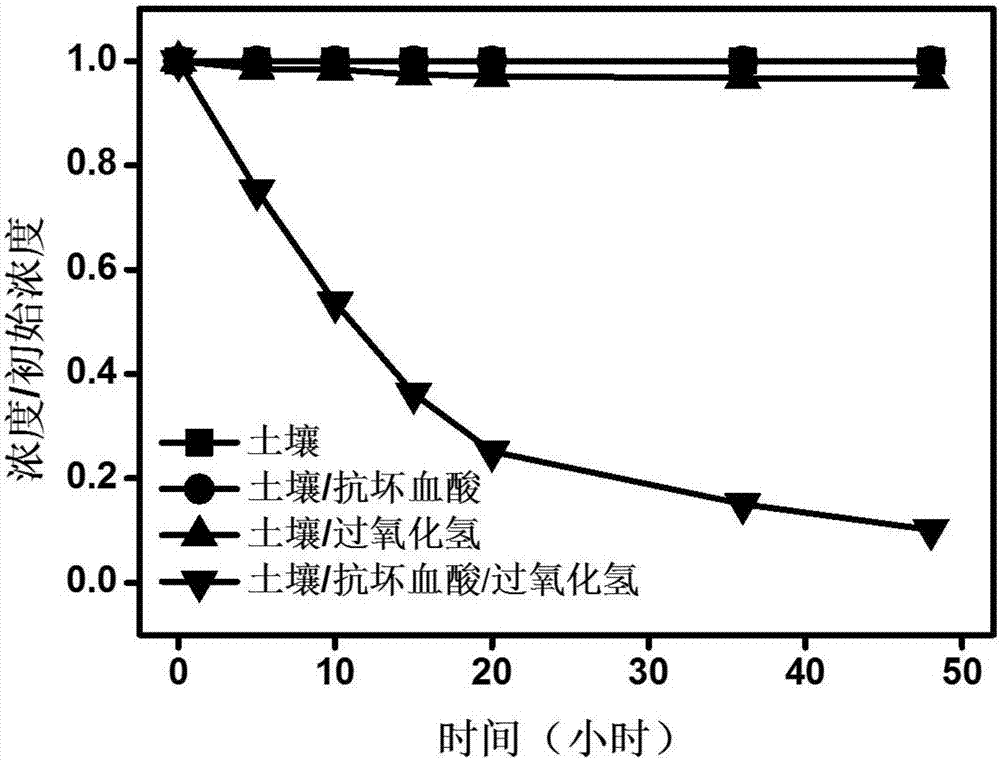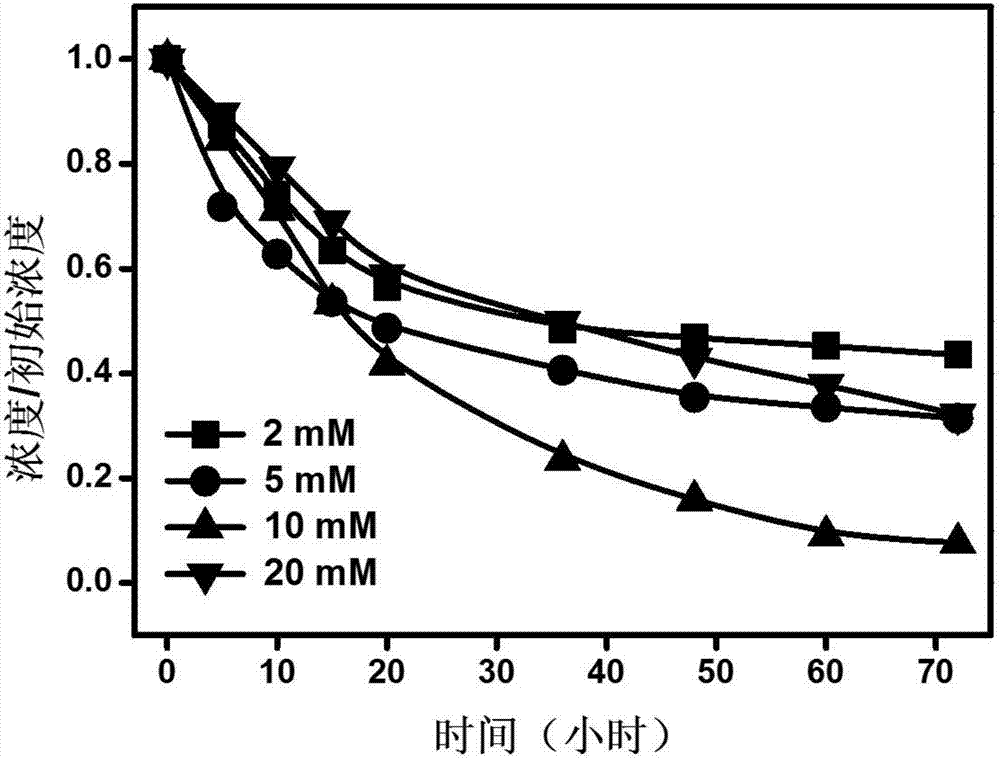Organic polluted site soil in-situ chemical oxidation repairing method based on iron cycling regulation
An in-situ chemical oxidation and organic pollution technology, applied in the field of environmental chemistry, to achieve the effects of wide application range, environmental friendliness and mild reaction conditions
- Summary
- Abstract
- Description
- Claims
- Application Information
AI Technical Summary
Problems solved by technology
Method used
Image
Examples
Embodiment 1
[0038] Embodiment 1 Remediation of Chloronitrobenzene Contaminated Site Soil
[0039] The soil of the organic contaminated site was taken from the chloronitrobenzene contaminated site of an abandoned chemical plant. After sampling, the contaminated soil was freeze-dried, crushed, and ground to form a uniform soil sample. The main organic pollutants in the contaminated soil were determined by mass spectrometry to be o-chloronitrobenzene and p-chloronitrobenzene.
[0040] For the remediation of chloronitrobenzene-contaminated soil, add 1mL of ascorbic acid and hydrogen peroxide mixed solution to 1g of soil, so that the concentrations of ascorbic acid and hydrogen peroxide are 10mmol / L and 200mmol / L, respectively, without additional pH adjustment. place. At the same time, no ascorbic acid and hydrogen peroxide, only ascorbic acid or only hydrogen peroxide were used as control experiments. The concentrations of ascorbic acid and hydrogen peroxide in the control experiment were 10...
Embodiment 2
[0041] Example 2 Restoration of Chloronitrobenzene Contaminated Site Soil under Different Ascorbic Acid Concentrations
[0042] The soil of the organic contaminated site was taken from the chloronitrobenzene contaminated site of an abandoned chemical plant. After sampling, the contaminated soil was freeze-dried, crushed, and ground to form a uniform soil sample. It was determined by mass spectrometry that the contaminated soil contained o-chloronitrobenzene and p-chloronitrobenzene.
[0043]For the remediation of chloronitrobenzene-contaminated site soil, add 1mL of ascorbic acid and hydrogen peroxide mixed solution to 1g of soil, so that the concentration of hydrogen peroxide is 200mmol / L, and the concentration of ascorbic acid is 2, 5, 10 and 20mmol respectively / L, no need to adjust the pH, stand still, monitor the degradation of o-chloronitrobenzene and p-chloronitrobenzene respectively, the results are shown in image 3 and Figure 4 . image 3 As shown, as the initial...
Embodiment 3
[0044] Embodiment 3 Remediation of Chloronitrobenzene Contaminated Site Soil under Different Hydrogen Peroxide Concentrations
[0045] The soil of the organic contaminated site was taken from the chloronitrobenzene contaminated site of an abandoned chemical plant. After sampling, the contaminated soil was freeze-dried, crushed, and ground to form a uniform soil sample. It was determined by mass spectrometry that the contaminated soil contained o-chloronitrobenzene and p-chloronitrobenzene.
[0046] For the remediation of chloronitrobenzene-contaminated site soil, add 1mL of ascorbic acid and hydrogen peroxide mixed solution to 1g of soil, so that the concentration of ascorbic acid is 10mmol / L, and the concentration of hydrogen peroxide is 100, 200, 500 and 1000mmol respectively / L, no need to adjust the pH, let it stand still. Simultaneously with not adding ascorbic acid as control test, monitor respectively the degradation situation of o-chloronitrobenzene and p-chloronitrob...
PUM
| Property | Measurement | Unit |
|---|---|---|
| Concentration | aaaaa | aaaaa |
Abstract
Description
Claims
Application Information
 Login to View More
Login to View More - R&D
- Intellectual Property
- Life Sciences
- Materials
- Tech Scout
- Unparalleled Data Quality
- Higher Quality Content
- 60% Fewer Hallucinations
Browse by: Latest US Patents, China's latest patents, Technical Efficacy Thesaurus, Application Domain, Technology Topic, Popular Technical Reports.
© 2025 PatSnap. All rights reserved.Legal|Privacy policy|Modern Slavery Act Transparency Statement|Sitemap|About US| Contact US: help@patsnap.com



